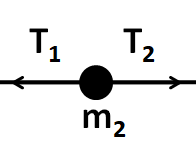Question
Question: Three solids of mass \( {m_1} \) , \( {m_2} \) and \( {m_3} \) are connected with weight less string...
Three solids of mass m1 , m2 and m3 are connected with weight less string in succession and are placed on a frictionless table. If the mass m3 is dragged with a force T . The tension in the string between m2 and m3 is:-
(A) m1+m2+m3m2T
(B) m1+m2+m3m3T
(C) m1+m2+m3m1+m2T
(D) m1+m2+m3m2+m3T
Solution
Hint To solve this question, we have to determine the common acceleration of the whole system of the three masses. Then, by applying Newton's second and third laws we will get the final value of the required tension.
Formula Used: The formula used to solve this question is given by
⇒F=ma , here F is the force acting on a body of mass m which is having an acceleration of a .
Complete step by step answer
Consider the system of masses connected by strings in succession as shown in the figure below. Let the tension in the string between the masses m1 and m2 be T1 and that between the masses m2 and m3 be T2

Let the common acceleration of the system be a .
As we can clearly see, the only external force on this system is the force T . So from the equation of the whole system we have,
⇒F=T …………………………...(1)
Also, the total mass of this system is
⇒M=m1+m2+m3 …………………………...(2)
So from the Newton’s second law of motion we have
⇒F=Ma
Putting the values from (1) and (2) we get
⇒T=(m1+m2+m3)a
So we get the common acceleration of the system as
⇒a=(m1+m2+m3)T …………………………...(3)
Now, consider the free body diagram of the mass m1 .

We can see that the net force on m1 is
⇒F1=T1 …………………………...(4)
Also, its acceleration is equal to the acceleration of the system. So, from the Newton’s second law we get
⇒F1=m1a
From (3) and (4)
⇒T1=m1(m1+m2+m3)T
⇒T1=(m1+m2+m3)m1T …………………………...(5)
Now, we consider the free body diagram of the mass m2 .

We can see that the net force on m2 is
⇒F2=T2−T1 …………………………...(6)
From the Newton’s second law we get
⇒F2=m2a
From (3) and (6) by substituting we get
⇒T2−T1=m2(m1+m2+m3)T
From (5) we can substitute the value of T1 . So we get,
⇒T2−(m1+m2+m3)m1T=m2(m1+m2+m3)T
Therefore the tension T2 is
⇒T2=(m1+m2+m3)m1T+m2(m1+m2+m3)T
On simplifying, we get
⇒T2=m1+m2+m3m1+m2T
Therefore, the tension in the string connecting the masses m2 and m3 is equal to m1+m2+m3m1+m2T
Hence the correct answer is option C.
Note
Instead of considering the free body diagrams of the masses m1 and m2 , we could have considered that of the mass m3 only. By applying Newton’s second law on the motion of the mass m3 , we could have directly got the required value of the tension.
